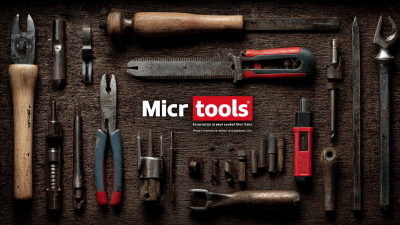The rapid evolution of technology continues to redefine the way we approach tasks in both
personal and professional environments. As we look toward 2025,
the rise of micro tools
has emerged as a key driver of efficiency and productivity across various industries.
According to a recent report by McKinsey & Company, organizations that adopt
innovative micro tools can enhance their operational efficiency by up to 40%.
These compact yet powerful digital solutions streamline workflows, facilitate real-time collaboration,
and automate mundane tasks, allowing teams to focus on creative problem-solving.

Moreover, a study by Deloitte highlights that 80% of businesses plan to invest in micro tools within the next two years, indicating a significant shift toward optimizing processes through digital innovation. From project management applications to AI-driven analytics platforms, the utilization of micro tools provides practical solutions tailored to modern business challenges. In this evolving landscape, understanding the capabilities and benefits of these tools is essential for organizations aiming to maintain a competitive edge and unlock their full potential in the coming years.
The rise of micro tools in digital innovation marks a significant shift in how individuals and businesses streamline processes and enhance productivity. As technology evolves, these compact and specialized tools have become essential for tackling specific tasks more efficiently. Unlike traditional software solutions that often encompass a wide range of features, micro tools focus on solving singular problems, which allows users to achieve quicker results without the overhead of unnecessary complexity.

In 2025, we are likely to witness an explosion of micro tools tailored to various niches, driven by the growing demand for agility and efficiency in both personal and professional settings. These tools harness advancements in artificial intelligence, machine learning, and automation to provide tailored solutions that adapt to user needs. By integrating seamlessly into existing workflows, they enable users to optimize their time and resources, fostering an environment where innovation can thrive.
As this trend continues, we can expect to see an emphasis on collaboration, with micro tools facilitating seamless communication and task management across teams and workflows, ultimately redefining digital innovations for the modern age.
In 2025, the landscape of digital tools has transformed significantly, with micro tools leading the charge in enhancing productivity and streamlining workflows. One key feature of these innovations is their integration capability. By allowing seamless connectivity with other software and platforms, users can automate tasks and consolidate information efficiently, reducing the time spent on manual inputs. This interoperability not only simplifies complex processes but also fosters collaboration among team members, making it easier to manage projects in a decentralized work environment.

Another standout feature of 2025’s most effective micro tools is their user-centric design. These tools prioritize intuitive interfaces that minimize the learning curve, enabling users to adapt quickly without extensive training. Moreover, many micro tools now leverage artificial intelligence to provide personalized user experiences, anticipating needs and suggesting relevant actions. This customization enhances workflow and significantly boosts efficiency, empowering users to focus on high-value tasks. As micro tools continue to evolve, their capacity for smart integration and user-centered design will be pivotal in shaping the future of work.
In the rapidly evolving digital landscape, micro tools are becoming essential for enhancing productivity and streamlining workflows. A recent report from McKinsey states that organizations using specialized micro tools can improve their productivity by up to 30%, as these tools enable teams to automate routine tasks and focus on more complex challenges. By integrating micro tools that are tailored to specific functions, such as project management or communication, businesses are witnessing a significant reduction in time spent on administrative duties.
Moreover, the adoption of micro tools has transformed the way teams collaborate. According to a study by Gartner, companies that implement micro tool ecosystems see a 25% increase in team engagement, thanks largely to the intuitive design and functionality of these tools. By allowing for seamless integration with existing workflows, micro tools facilitate better communication and information sharing among team members, ultimately fostering more cohesive collaborations that drive innovation and efficiency in the workplace. As we look to 2025, the impact of micro tools on enhancing workflow and productivity cannot be overstated, making them indispensable for any organization aiming for excellence.
This chart illustrates the potential productivity boost offered by various micro tools in 2025. Data suggests that automation software and collaboration tools provide the highest increase in productivity, highlighting their significance in enhancing workflow.
In the rapidly evolving landscape of digital innovations, micro tools have emerged as pivotal contributors to enhancing efficiency across various industries. A study by McKinsey & Company revealed that organizations utilizing micro tools for task management and productivity saw an average productivity boost of 15-25%. These tools enable teams to streamline workflows, reduce bottlenecks, and promote collaborative environments, leading to tangible improvements in project completion rates.
One remarkable case study is that of a renowned tech startup that implemented a micro tool for real-time collaboration during remote work transitions prompted by the pandemic. The tool enabled seamless communication and project tracking, resulting in a dramatic 40% increase in team efficiency and a 30% decrease in project turnaround time. Similarly, a retail company leveraged micro analytics to gain insights into customer behavior, ultimately enhancing their marketing strategies and increasing sales by 20% over a six-month period. Such success stories underscore the transformative power of micro tools, proving that when utilized effectively, they can revolutionize traditional workflows and drive substantial growth.
As we look ahead to 2025, the micro tool development landscape is poised for significant advancements, driven by the increasing demand for efficiency in various industries. According to a report by MarketsandMarkets, the global micro tools market is expected to grow from USD 15 billion in 2020 to USD 24 billion by 2025, reflecting a compound annual growth rate (CAGR) of 10.2%. This growth is largely fueled by the integration of automation and smart technologies, which enhance productivity and precision in manufacturing processes.
Future trends indicate a shift towards miniaturization and customization, particularly in sectors like electronics and healthcare. The rise of Internet of Things (IoT) devices is likely to lead to the development of micro tools that are not only more efficient but also connect seamlessly to larger systems for real-time data analysis. Industry experts predict that by 2025, over 75% of manufacturing firms will invest in smart micro tools that leverage artificial intelligence and machine learning capabilities to optimize performance. These trends signify a transformative phase where micro tools will redefine operational efficiencies and open new avenues for innovation across multiple sectors.
| Micro Tool | Innovation Type | Key Features | Expected Impact | Adoption Rate (%) |
|---|---|---|---|---|
| Smart Micro Sensors | IoT Integration | Real-time monitoring, low power consumption | Enhanced data collection | 75% |
| AI-driven Analysis Tools | Data Analytics | Predictive analytics, automated reporting | Improved decision-making | 70% |
| Portable Hardware Tools | Mobile Innovation | Compact design, multi-functional use | Increased efficiency in fieldwork | 65% |
| Cloud-based Collaboration Tools | Remote Work Solutions | Real-time collaboration, task management | Boosted productivity in teams | 80% |
| Augmented Reality Interfaces | Immersive Technology | Interactive user experience, visualization tools | Enhanced training and presentations | 60% |






Contact
KYOCERA SGS Precision Tools, Inc.
(330) 686-5700
150 Marc Drive
Cuyahoga Falls, OH 44223
Products
Resources